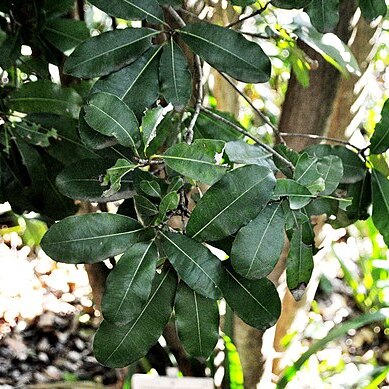Perennial tree or shrub, 4-10 m high, bark grey. Leaves glabrous, narrowly obovate, apex acute to apiculate, margins revolute; petioles up to 10 mm long. Flowers white-yellow, up to 4 in axil; pedicels pubescent, up to 30 mm long. Calyx 6-lobed, divided nearly to base, up to 9 mm long. Corolla 3-or 4-merous; tube short; lobes and lateral appendages subequal. Stamens up to 8; anthers up to 2.5 mm long. Ovary ± 8 locular, subglobose; style terete, obtuse. Flowering time Sept.-Nov. Fruit 1(2)-seeded, ellipsoid with pointed apex, up to 50 x 35 mm, purplish red. Seeds testa thin and broad scar, 20-25 mm long.
A small evergreen tree. It grows 6 m high. The stem is 30 cm across. The branches are often held horizontally. The leaves are on short, thick, rigid small branches. They are broadly oval and 7-16 cm long by 3-7 cm wide. They taper to the base. They are dark green and shiny above and more pale underneath. The midrib is yellow. The flowers are white or cream and 1 cm long. They are in clusters of 2-4 flowers. These are in the axils of leaves at the ends of branches. The fruit are oval and have sepals around the base. They are green but ripen to red.
Leaves glabrous; lamina 4·5–10 x 1·5–4 cm., narrowly obovate, apex acute to cuspidate–apiculate, base tapering gradually; midrib and the very fine vein reticulation raised on both surfaces; margin revolute; petiole 6–10 mm. long.
Fruit up to 5 cm. long and 3·5(5) cm. in diameter, ovoid, ellipsoid or globose, with pointed apex, glabrous and purplish–red when ripe; fruiting calyx spreading to reflexed.
Flowers white, in 1–4–flowered axillary fascicles, on ferrugineous–pubescent pedicels up to 3 cm. long, each subtended by a minute, broadly triangular, caducous bract.
Tree, 6-20 m high. Leaves usually longer than 60 mm, generally obovate, petiole usually longer than 10 mm. Pedicels 20-50 mm long. Flowers dull white.
Corolla c. 8·5 mm. long; tube c. 1 mm. long; median and lateral lobes similar, narrowly oblong–elliptic.
Young sterns glabrous or ferrugineous–pubescent and soon glabrescent; bark grey, striated.
Staminodes c. 4·5 mm. long.
Shrub or tree 3–7 m. tall.
Gynoecium c. 13 mm. long.
Anthers c. 2·5 mm. long.
Calyx c. 9 mm. long.
Seed 20–25 mm. long.

